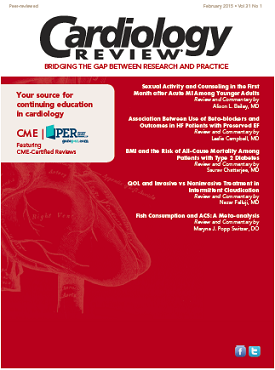Publication
Article
Cardiology Review® Online
New Challenges, New Pressures in Cardiology
Author(s):
With the fifth anniversary of the signing of the Affordable Care Act (ACA) into law upon us, ample time has passed to allow us to take stock of the law's effects on the practice and business of cardiology, and to make some informed predictions regarding future developments.

Mike Hennessy
With the fifth anniversary of the signing of the Affordable Care Act (ACA) into law upon us, ample time has passed to allow us to take stock of the law’s effects on the practice and business of cardiology, and to make some informed predictions regarding future developments.
At the recently concluded 2015 Annual Scientific Sessions of the American College of Cardiology, the co-editor-in-chief of The American Journal of Managed Care (also published by our company), Michael E. Chernew, PhD, professor of Healthcare Policy at Harvard Medical School, delivered a presentation on several ways in which the implementation of the ACA has changed the practice of cardiology. Chernew’s talk paid particular attention to the impact of new payment models and accountable care organizations (ACOs).
As noted in this summary of Chernew’s remarks (http://bit.ly/1Ircwh4), cardiologists “are affected by these changes more than most specialists, as a sizable share of their patients are older, sicker, and reliant on Medicare, which is demanding that physicians change the way they do business.” The most prominent change facing cardiologists and physicians in all specialties is the ongoing move from the traditional fee for service model to an approach that ties payment to value, bundling care across time and provider type.
One of the leading elements of this transition has been the emergence of ACOs, which are defined in the summary linked to above as “healthcare systems that take responsibility for patients at all levels of care, while giving those systems opportunities to share in savings if they produce better-than-expected health outcomes for their patient populations.” Chernew noted that although ACOs were designed to ensure coordination of care and slow spending growth (which he said has definitely happened for cardiologists), the organizations are not without their own challenges, including misaligned incentives, patients seeking care from more than one ACO (and also from non-ACO-affiliated providers), and complex payment benchmarks.
Chernew and another speaker in the session both reiterated that controlling costs in the era of bundled payments is going to come down to learning to better manage outpatient care, and that the shift from fee for service to payment for value is going to put more risk on providers. Local competition and increased consumerism that pushes patients to seek out and compare information on pricing and performance measures are going to drive the market.
Above all, cardiologists have to be proactive in embracing these changes, and get ahead of the curve by working for payment reform in their institutions, show they can contribute value and savings in areas like chronic disease management, and protecting (to the extent they can) extant fee-for-service revenue.
Another speaker underscored the importance of cardiologists becoming more involved in outpatient care, noting that this will represent a true change of mindset, because many practitioners have spent careers doing procedures that had little to do with outpatient care. This means that cardiologists will need to pay more attention to what happens after their patients leave the hospital (better coordination during transitions of care and more focus on where the patient is being discharged to).
We are living through a time of great upheaval and change in health care. Many old ways of doing business and thinking about patient care are going to fall by the wayside as newer approaches that prioritize quality of care and value of service are adopted.
Thank you for reading.
Mike Hennessy
Chairman, Chief Executive Officer






